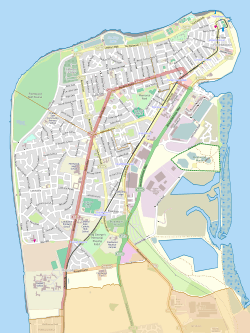North Euston Hotel
| North Euston Hotel | |
|---|---|
 | |
 Location within Fleetwood | |
| General information | |
| Location | Fleetwood, Lancashire, England |
| Coordinates | 53°55′40.8″N 3°0′33.12″W / 53.928000°N 3.0092000°WCoordinates: 53°55′40.8″N 3°0′33.12″W / 53.928000°N 3.0092000°W |
| Opening | 1841 |
| Owner | Spearman family[1] |
| Design and construction | |
| Architect | Decimus Burton |
Listed Building – Grade II | |
| Designated | 26 April 1950 |
| Reference no. | 1362181 |
The North Euston Hotel is a hotel in Fleetwood, Lancashire, England. It was built 1840–41, to a design by Decimus Burton. During the second half of the 19th century, the building was used by the War Department as a School of Musketry; by the end of the century it had reverted to its original purpose. The hotel has been designated a Grade II listed building by English Heritage.
History
Fleetwood was a 19th-century planned town, developed by local landowner Peter Hesketh-Fleetwood. Inspired by southern English seaside resorts like St Leonards-on-Sea, Hesketh-Fleetwood employed architect Decimus Burton to lay out his new town and design the main buildings.[2] Hesketh-Fleetwood intended that Fleetwood would be an important stop for rail passengers travelling from London to Scotland; in the 1840s, there was no railway over the Lake District hills and passengers would be able to disembark at Fleetwood before taking a boat to Scotland.[3] A hotel was a vital part of this plan and since rail passengers would be embarking at London Euston, Hesketh-Fleetwood decided to name it the North Euston Hotel.[4]
Burton designed the hotel as a focal point in the town.[5] Construction started in 1840 and it opened the following year.[6] A regatta was held in celebration of the hotel's opening in August 1841.[7] The hotel's first manager was a Corsican man called Xenon Vantini.[8] By the 1850s, a direct rail route to Scotland had been built, ending Hesketh-Fleetwood's hopes of Fleetwood becoming a major transport hub.[9] The town's tourist industry was failing and the North Euston was sold to the government.[10] From 1861–1867 the War Department used it as a School of Musketry. Later, with additional buildings, it was converted into Euston Barracks.[9][11] In 1898 the North Euston reverted to its original purpose.[10]
On 26 April 1950 English Heritage designated the hotel a Grade II listed building.[6] The Grade II designation—the lowest of the three grades—is for buildings that are "nationally important and of special interest".[12]
Architecture
The hotel is built of ashlar with slate roofs.[6] It has a curved plan, with a front façade that stretches approximately 300 yards (270 m).[13] The north and south wings have two regular storeys with a mansard roof, and dormers providing accommodation on the third floor. The central portion has three full storeys. The north wing, which faces along the Esplanade, curves almost a full 90 degrees, while the south wing is shorter, curving roughly 45 degrees. At the front of the building there is a porte-cochère (porch) supported by fluted Roman Doric columns.[14]
See also
References
- Notes
- Footnotes
- ↑ "Couple Snap up Euston Hotel", Blackpool Gazette (Johnston Press), 14 October 2009, retrieved 10 July 2011
- ↑ Curtis (1994), p. 52
- ↑ Curtis (1994), p. 40
- ↑ Curtis (1994), p. 53
- ↑ Taylor & Payne (2008), p. 38
- ↑ 6.0 6.1 6.2 "North Euston Hotel, Euston Crescent", National Heritage List for England (English Heritage), retrieved 10 July 2011
- ↑ Wigglesworth (1992), p. 38
- ↑ Curtis (1994), p. 78
- ↑ 9.0 9.1 Taylor & Payne (2008), p. 39
- ↑ 10.0 10.1 Lancashire County Council & Egerton Lea Consultancy (2005), p. 23
- ↑ Porter (1876), p. 225
- ↑ "Listed Buildings", National Heritage List for England (English Heritage), retrieved 10 July 2011
- ↑ "School of Musketry at Fleetwood", London Society (William Clowes and Sons) 5, 1864: 81–84
- ↑ Hartwell & Pevsner (2009), p. 295
- Bibliography
- Curtis, Bill (1994), The Golden Dream: The Biography of Sir Peter Hesketh-Fleetwood, Life Publications, ISBN 1-68874-371-5
- Hartwell, Clare; Pevsner, Nikolaus (2009) [1969], Lancashire: North, New Haven and London: Yale University Press, ISBN 0-300-12667-0
- Lancashire County Council and Egerton Lea Consultancy (April 2005), "Fleetwood Historic Town Assessment Report" (PDF), Lancashire Historic Town Survey Programme (Lancashire County Council Environment Directorate), retrieved 10 July 2011
- Porter, John (1876), History of the Fylde of Lancashire, W. Porter, OCLC 12931605
- Taylor, Vivien; Payne, Garry (19 May 2008), Fleetwood Conservation Area Appraisal and Management Plan (PDF), Wyre Borough Council, retrieved 20 June 2011
- Wigglesworth, Neil (1992), The Social History of English Rowing, Routledge, ISBN 0-7146-3415-8
Further reading
- Curtis, Bill (1992), The North Euston Hotel: A Brief History, ISBN 1-68874-368-5
External links
 Media related to North Euston Hotel at Wikimedia Commons
Media related to North Euston Hotel at Wikimedia Commons- Official website
| ||||||||||||||||||||||||||||||||||||||||||||||